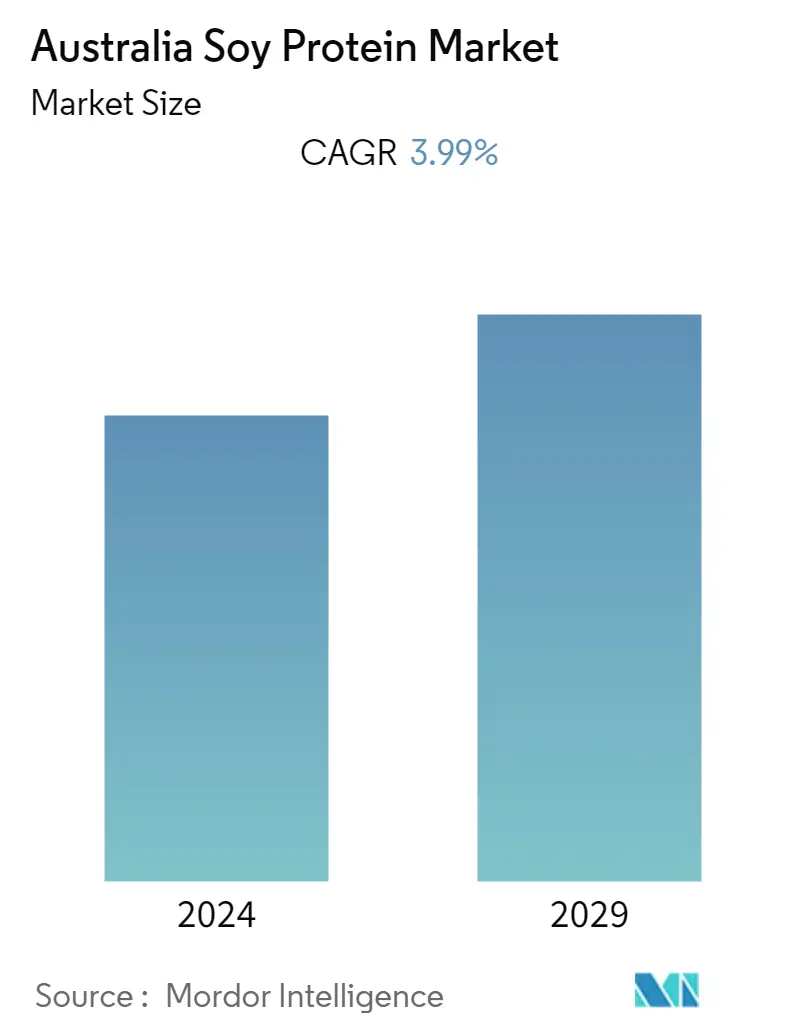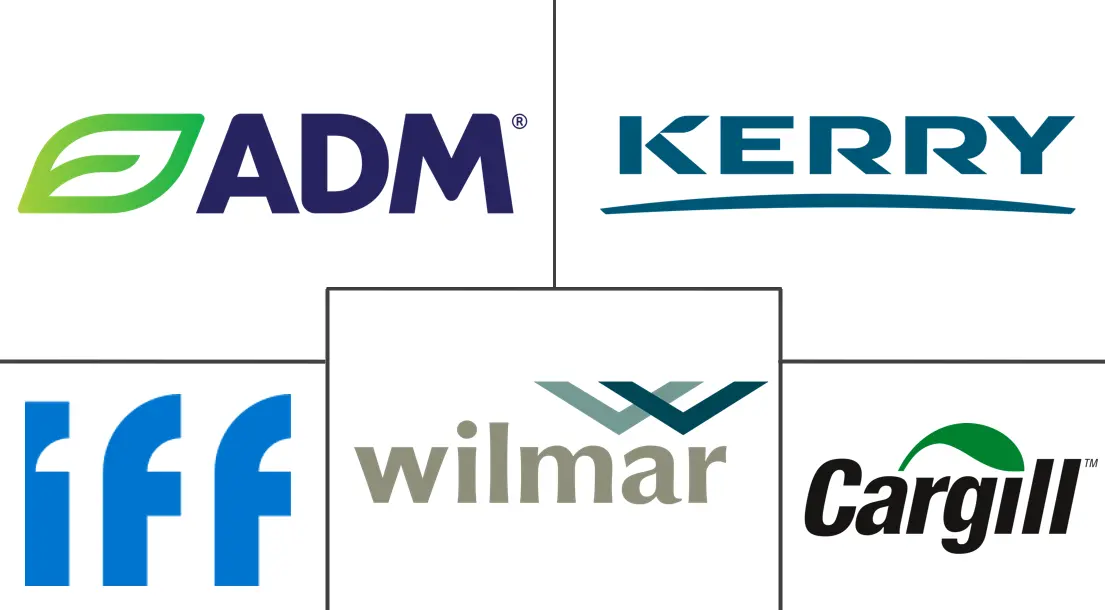Market Size of Australia Soy Protein Industry

| Study Period | 2019 - 2029 |
| Base Year For Estimation | 2023 |
| Forecast Data Period | 2024 - 2029 |
| Historical Data Period | 2019 - 2022 |
| CAGR | 3.99 % |
| Market Concentration | Low |
Major Players
*Disclaimer: Major Players sorted in no particular order |
Australia Soy Protein Market Analysis
The Australia soy protein market size is expected to grow from USD 85.13 million in 2023 to USD 103.50 million by 2028, at a CAGR of 3.99% during the forecast period (2023-2028).
- The Australian soy protein market is primarily driven by its applications in the food and beverage industry. The demand for plant-based meat products is increasing in the country owing to the increasing demand for clean-label food in the market. Additionally, due to rising health consciousness and increasing demand for functional and nutritional food, the demand for soy protein is growing. The soy protein concentrates are claimed to provide good protein content, better hydration, and immunity-boosting nutrients.
- The high penetration rate of soy protein in the Australian food and beverage market can be attributed to the abundant availability of raw materials and lower prices. During the review period, soy protein was 40%-50% cheaper than other proteins, like pea protein. Steady innovations in the RTE food segment led to the wide application of soy protein incorporated in various products, such as burger patties, minced meat analog, meatballs, and sausages. Owing to this, the use of soy protein concentrate as a bakery ingredient is increasing.
- Additionally, the demand for soy protein in animal feed is also increasing owing to the increasing demand for nutritional animal feed among meat suppliers. According to Alltech Feed Survey 2021, animal feed production in Australia majorly comes from more than 160 mills in the country. In animal feed, soy protein is primarily used as a dairy substitute and fishmeal for its functionalities, including high protein digestibility, cheaper price point, low anti-nutritional content, and longer shelf life.
- Furthermore, the production of soya beans is increasing in Australia owing to the environmental conditions and market demand for plant-based ingredients. According to the Australian Bureau of Statistics, the soybean yield in Australia in 2021 was 1.7 million metric tons per hectare.
Australia Soy Protein Industry Segmentation
Soy protein is defined as the protein sourced from soybeans, these are often used as a replacement for proteins sourced from animals.
Australia's soy protein market is segmented by form and end-user. By form, the market is segmented into concentrates, isolates, and textured/hydrolyzed. Based on end-user, the market is segmented into animal feed, personal care and cosmetics, food and beverages, and supplements. The food and beverages segments of the market are further segmented into bakery, beverages, breakfast cereals, condiments/sauces, dairy/dairy alternatives, meat/poultry/seafood and meat alternative products, RTE (ready-to-eat) & RTC (ready-to-cook) food products, and snacks. The supplements segment of the end-user segment is further segmented into baby food and infant formula, elderly nutrition & medical nutrition, and sports/performance nutrition.
The market sizing has been done in value terms in USD and for volume terms in volume in tons for all the abovementioned segments.
| Form | |
| Concentrates | |
| Isolates | |
| Textured/Hydrolyzed |
| End User | ||||||||||
| Animal Feed | ||||||||||
| Personal Care and Cosmetics | ||||||||||
| ||||||||||
|
Australia Soy Protein Market Size Summary
The Australian soy protein market is experiencing a notable expansion, driven primarily by its increasing application in the food and beverage sector. The rising demand for plant-based meat products, fueled by a shift towards clean-label and health-conscious food options, is a significant factor propelling market growth. Soy protein concentrates are particularly valued for their high protein content, hydration properties, and immunity-boosting nutrients. The market benefits from the abundant availability of raw materials and cost-effectiveness, with soy protein being significantly cheaper than alternatives like pea protein. Innovations in ready-to-eat food products have further broadened the application of soy protein, integrating it into various food items such as burger patties, meat analogs, and sausages. Additionally, the demand for soy protein in animal feed is on the rise, driven by the need for nutritional animal feed among meat suppliers, with soy protein being used as a dairy substitute and fishmeal due to its digestibility and cost advantages.
The shift from animal to plant-based proteins is influenced by ecological, health, ethical, and environmental concerns, leading to increased consumer interest in soy protein as a meat substitute. This trend is particularly evident among vegan and flexitarian consumers, who seek meat-like nutrition profiles in their diets. The growth of the plant-based meat industry, supported by facilities like Harvest B's new plant-based meat ingredient facility in Western Sydney, underscores the expanding role of soy protein in this sector. The animal feed industry also plays a crucial role in the market's growth, with soy protein meal being a primary source of protein for livestock, particularly pigs and poultry. The fragmented nature of the market sees major players like Cargill, Archer Daniels Midland Company, and Kerry Group PLC employing strategies such as partnerships and expansions to strengthen their market presence. These developments, coupled with ongoing research and innovation, are set to drive the Australian soy protein market forward in the coming years.
Australia Soy Protein Market Size - Table of Contents
-
1. MARKET DYNAMICS
-
1.1 Market Drivers
-
1.1.1 Rising Demand for Plant-based Protein Sources
-
1.1.2 Strategic Investments by Players Operating in the Market
-
-
1.2 Market Restraints
-
1.2.1 Availability of Substitute Protein Sources
-
-
1.3 Porter's Five Forces Analysis
-
1.3.1 Threat of New Entrants
-
1.3.2 Bargaining Power of Buyers/Consumers
-
1.3.3 Bargaining Power of Suppliers
-
1.3.4 Threat of Substitute Products
-
1.3.5 Intensity of Competitive Rivalry
-
-
-
2. MARKET SEGMENTATION
-
2.1 Form
-
2.1.1 Concentrates
-
2.1.2 Isolates
-
2.1.3 Textured/Hydrolyzed
-
-
2.2 End User
-
2.2.1 Animal Feed
-
2.2.2 Personal Care and Cosmetics
-
2.2.3 Food and Beverages
-
2.2.3.1 Bakery
-
2.2.3.2 Beverages
-
2.2.3.3 Breakfast Cereals
-
2.2.3.4 Condiments/Sauces
-
2.2.3.5 Dairy and Dairy Alternative Products
-
2.2.3.6 Meat/Poultry/Seafood and Meat Alternative Products
-
2.2.3.7 RTE/RTC Food Products
-
2.2.3.8 Snacks
-
-
2.2.4 Supplements
-
2.2.4.1 Baby Food and Infant Formula
-
2.2.4.2 Elderly Nutrition and Medical Nutrition
-
2.2.4.3 Sport/Performance Nutrition
-
-
-
Australia Soy Protein Market Size FAQs
What is the current Australia Soy Protein Market size?
The Australia Soy Protein Market is projected to register a CAGR of 3.99% during the forecast period (2024-2029)
Who are the key players in Australia Soy Protein Market?
Kerry Group PLC, International Flavors & Fragrances, Inc., The Archer-Daniels-Midland Company, Wilmar International Ltd and Cargill, Incorporated, are the major companies operating in the Australia Soy Protein Market.

